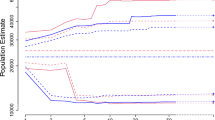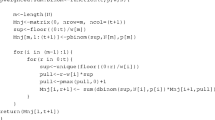Abstract
Asymptotic properties of the parametric bootstrap procedure for maximum pseudolikelihood estimators and hypothesis tests are studied in the general framework of associated populations. The technique is applied to the analysis of toxicological experiments which, based on pseudolikelihood inference for clustered binary data, fits into this framework. It is shown that the bootstrap approximation can be used as an interesting alternative to the classical asymptotic distribution of estimators and test statistics. Finite sample simulations for clustered binary data models confirm the asymptotic theory and indicate some substantial improvements.
Similar content being viewed by others
REFERENCES
Arnold, B. C. and Strauss, D. (1991). Pseudolikelihood estimation: Some examples, Sankhya Ser. B, 53, 233–243.
Beran, R. (1988). Prepivoting test statistics: A bootstrap view of asymptotic refinements. J. Amer. Statist. Assoc., 83, 687–697.
Besag, J. (1975). Statistical analysis of non-lattice data, The Statistician, 24, 179–195.
Bradley, R. A. and Gart, J. J. (1962). The asymptotic properties of ML estimators when sampling from associated populations, Biometrika, 49, 205–214.
Carr, G. J. and Portier, C. J. (1993). An evaluation of some methods for fitting dose-response models to quantal-response developmental toxicology data, Biometrics, 49, 779–791.
Chanda, K. C. (1954). A note on the consistency and maxima of the roots of likelihood equations, Biometrika, 41, 56–61.
Chandra, T. K. and Joshi, S. N. (1983). Comparison of the likelihood ratio, Rao's and Wald's tests and a conjecture of C. R. Rao, Sankhya Ser. A, 45, 226–246.
Chandra, T. K. and Mukerjee, R. (1984). On the optimality of Rao's statistic, Comm. Statist. Theory Methods, 13, 1507–1515.
Chandra, T. K. and Mukerjee, R. (1985). Comparison of the likelihood ratio, Wald's and Rao's tests, Sankhya Ser. A, 47, 271–284.
Cordeiro, G. M., Botter, D. A. and Ferrari, S. L. P. (1994). Nonnull asymptotic distributions of three classic criteria in generalized linear models, Biometrika, 81, 709–720.
Cox, D. R. (1972). The analysis of multivariate binary data, Applied Statistics, 21, 113–120.
Cox, D. R. and Wermuth, N. (1994). A note on the quadratic exponential binary distribution, Biometrika, 81, 403–408.
Cressie, N. (1991). Statistics for Spatial Data, Wiley, New York.
Frangos, C. C. and Schucany, W. R. (1995). Improved bootstrap confidence intervals in certain toxicological experiments, Comm. Statist. Theory Methods, 24, 829–844.
Geys, H., Molenberghs, G. and Ryan, L. (1997). Pseudo-likelihood inference for clustered binary data, Comm. Statist. Theory Methods, 26, 2743–2768.
Geys, H., Molonberghs, G. and Ryan, L. (1999). Pseudo likelihood modelling of multivariate outcomes in developmental toxicity, J. Amer. Statist. Assoc. (to appear).
Kupper, L. L., Portier, C., Hogan, M. D. and Yamamoto, E. (1986). The impact of litter effects on dose-response modeling in teratology, Biometrics, 42, 85–98.
Lehmann, E. L. (1983). Theory of Point Estimation, Wiley, New York.
Lockhart, A.-M. C., Piegorsch, W. W. and Bishop, J. B. (1992). Assessing overdispersion and dose-response in the male dominant lethal assay, Mutation Research, 272, 35–58.
Molenberghs, G. and Ryan, L. (1999). Likelihood inference for clustered multivariate binary data, Environmetrics (to appear).
Morgan, B. J. T. (1992). Analysis of Quantal Response Data, Chapman and Hall, London.
Mukerjee, R. (1990a). Comparison of tests in the multiparameter case I: Second-order power, J. Multivariate Anal., 33, 17–30.
Mukerjee, R. (1990b). Comparison of tests in the multiparameter case II: A third-order optimality property of Rao's test, J. Multivariate Anal., 33, 31–48.
Pendergast, J. F., Gange, S. J., Newton, M. A., Linstrom, M. J., Palta, M. and Fisher, M. R. (1996). A survey of methods for analyzing clustered binary response data, International Statistical Review, 64, 89–118.
Phillips, P. C. B. and Park, J. Y. (1988). On the formulation of Wald tests of nonlinear restrictions, Econometrica, 56, 1065–1083.
Rotnitzky, A. and Jewell, N. P. (1990). Hypothesis testing of regression parameters in semiparametric generalized linear models for cluster correlated data, Biometrika, 77, 485–497.
Serfling, R. J. (1980). Approximation Theorems of Mathematical Statistics, Wiley, New York.
Author information
Authors and Affiliations
About this article
Cite this article
Aerts, M., Claeskens, G. Bootstrapping Pseudolikelihood Models for Clustered Binary Data. Annals of the Institute of Statistical Mathematics 51, 515–530 (1999). https://doi.org/10.1023/A:1003902206203
Issue Date:
DOI: https://doi.org/10.1023/A:1003902206203




